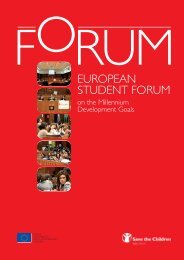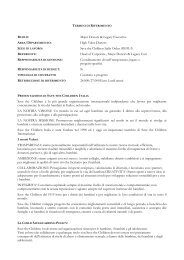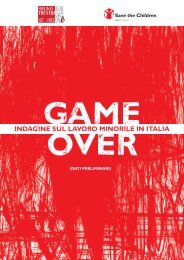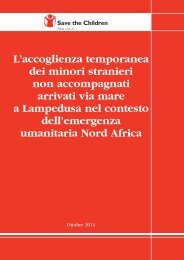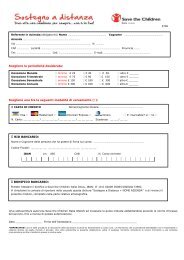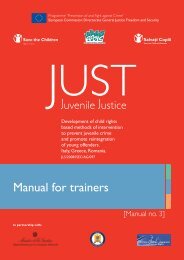<strong>FINAL</strong> <strong>REPORT</strong>Development of a Child Rights Methodology to Identify and Support Child Victims of Trafficking<strong>FINAL</strong> <strong>REPORT</strong>Development of a Child Rights Methodology to Identify and Support Child Victims of Trafficking1. THE AGIS PROJECTAND THE <strong>FINAL</strong> <strong>REPORT</strong>1.1 PROJECT DESCRIPTIONThe 24-month project, “Development of a child rights methodology to identify andsupport child victims of trafficking”, has been supported by <strong>the</strong> EuropeanCommission within <strong>the</strong> AGIS Programme 2005 and has been conducted betweenDecember 2005 and December 2007.It has been coordinated by <strong>Save</strong> <strong>the</strong> <strong>Children</strong> Italy and implemented in partnership with<strong>the</strong> Partners Bulgaria Foundation (Sofia, Bulgaria), Landes-Caritasverband Bayern e. V.(Munich, Germany) and <strong>Save</strong> <strong>the</strong> <strong>Children</strong> Romania (Bucharest, Romania).The project aims were to:• develop a child rights based methodology to correctly interview, properly identify andadequately support and assist child victims of trafficking;• streng<strong>the</strong>n <strong>the</strong> knowledge and professional skills of stakeholders working in <strong>the</strong> field ofchild trafficking.1.2 SCOPE AND ORGANISATIONOF THE <strong>REPORT</strong>This Final Report presents <strong>the</strong> main results of <strong>the</strong> project “Development of a childrights methodology to identify and support child victims of trafficking”, describedin <strong>the</strong> previous paragraph. It is divided in three parts.After presenting <strong>the</strong> methodology applied, in Part I, <strong>the</strong> report provides a summary of<strong>the</strong> research findings as resulting from <strong>the</strong> research activities conducted in each projectcountry. Thus, through direct reporting as well as case studies and direct testimonies, foreach project country, it highlights <strong>the</strong> main characteristics of child trafficking, drawing<strong>the</strong> profile of child victims, describing <strong>the</strong> way <strong>the</strong>y are recruited and transported, andpointing to <strong>the</strong> trafficking routes and countries involved in <strong>the</strong> trafficking cycle. It alsosheds some light on <strong>the</strong> conditions children live before being recruited and in <strong>the</strong> courseof trafficking, and gives some information on <strong>the</strong> forms of exploitation. Mostinformation ga<strong>the</strong>red concerns trafficking for <strong>the</strong> purpose of sexual exploitation andexploitation in illegal activities and begging. Instead, information obtained on traffickingfor exploitation in forced labour (e.g. agricultural work or work in <strong>the</strong> industry),trafficking of organs and trafficking for illegal adoptions is almost absent, due to <strong>the</strong>difficulty faced by <strong>the</strong> researchers in accessing reliable sources, <strong>the</strong> very nature oftrafficking (a criminal activity that is mostly hidden by its perpetrators), and <strong>the</strong> personalrisk or risk for <strong>the</strong> victims, resulting from <strong>the</strong> research.Information obtained through research has been fed into <strong>the</strong> child rights basedmethodology to identify and support child victims of trafficking. In particular, <strong>the</strong>research findings have been key in <strong>the</strong> development of specific tables of profiles of childvictims or children at risk of trafficking as well as of indicators for <strong>the</strong> identification ofchild victims. The Full Report of research findings is available on <strong>the</strong> coordinator andproject partners’ websites.To this end, <strong>the</strong> project promoted <strong>the</strong> realisation of several activities, including:• Research, conducted in <strong>the</strong> 4 project countries, namely, Bulgaria, Germany, Italy andRomania and concluded by April 2007. The initial project proposal limited <strong>the</strong>research focus to border crossing, requesting <strong>the</strong> implementing partners to undertake acomparative analysis of <strong>the</strong> modalities used by children to reach and cross nationalborders. Despite this, <strong>the</strong> project partners, in consultation with <strong>the</strong> coordinator havedecided to extend research activities to o<strong>the</strong>r crucial stages of <strong>the</strong> trafficking cycle(detailed under section 1.3), acknowledging that additional information was necessaryIn Part II, <strong>the</strong> report presents <strong>the</strong> child rights based methodological framework that hasto successfully achieve <strong>the</strong> objectives of <strong>the</strong> project.been used in <strong>the</strong> analysis of <strong>the</strong> practices and techniques for identification and support of• Identification of practices or techniques for identification and support of child victimschild victims collected in this project. It also provides a summary of <strong>the</strong> national legalof trafficking.frameworks applicable in each project country and a presentation of identification and• Analysis of <strong>the</strong> practices and techniques collected through <strong>the</strong> use of a child rightssupport practices and techniques, organized in four short reports, one per each projectbased methodological framework.country.• Development of a child rights based methodology to identify and support childvictims of trafficking: this methodology has been informed by latest research andFinally, Part III presents <strong>the</strong> methodology for <strong>the</strong> identification and support of childaccumulated experience as conducted and identified in this project.victims of trafficking (<strong>the</strong> AGIS methodology) developed in this project. It also presents• Consultation and training activities: over <strong>the</strong> months from September to November<strong>the</strong> activities carried out in <strong>the</strong> national seminars organised in <strong>the</strong> project countries,2007, relevant stakeholders, including, law enforcement agents, NGO representativeswhere <strong>the</strong> AGIS methodology was discussed with relevant stakeholders.and <strong>the</strong> judiciary, have been involved in 4 national seminars organised in <strong>the</strong> projectcountries. In <strong>the</strong>se occasions, <strong>the</strong> methodology on identification and support of childFinally, recommendations to relevant actors, including <strong>the</strong> EU Institutions to improvevictims has been shared with <strong>the</strong> participants, with a view to increasing <strong>the</strong>ir<strong>the</strong> protection of child victims and potential victims of trafficking, through identificationknowledge and skills. Fur<strong>the</strong>rmore, thanks to <strong>the</strong> valuable support and feedbackand support, are presented in chapter 9.received by <strong>the</strong> participants, <strong>the</strong> methodology has been improved.• The final conference: an international conference was organised on 13 DecemberThe content of this report has been summarized in <strong>the</strong> executive summary.2007, in <strong>the</strong> concluding phase of <strong>the</strong> project. In that context, main project researchfindings and <strong>the</strong> methodology for <strong>the</strong> identification and support of child victims of5UN Convention ontrafficking (<strong>the</strong> AGIS methodology) were presented and shared with guests and1.3 CHILD RIGHTS BASED APPROACH<strong>the</strong> Rights of <strong>the</strong> Child,participants. In addition, a specific protocol for <strong>the</strong> identification and support of childadopted on 20ANovember 1989 andvictims of trafficking developed in Italy by <strong>Save</strong> <strong>the</strong> <strong>Children</strong> (hereinafter, <strong>the</strong> <strong>Italia</strong>nrights based approach to child trafficking has been adopted in <strong>the</strong> AGIS project, as entered into force on 2Protocol), was presented, being it an example of an exhaustive tool for identifying andopposed to an approach guided by security and law enforcement concerns. The September 1990supporting child victims developed by using <strong>the</strong> AGIS methodology.pillar of such an approach is <strong>the</strong> UN Convention on <strong>the</strong> Rights of <strong>the</strong> Child (CRC) 5 , (Hereinafter “CRC”).6The Full Report and a Summary of <strong>the</strong> research findings as well as <strong>the</strong> Presentation ofwhich, toge<strong>the</strong>r with its Optional Protocol on <strong>the</strong> Sale of <strong>Children</strong>, Child Prostitution Optional Protocol to<strong>the</strong> CRC on <strong>the</strong> Sale of<strong>the</strong> AGIS methodology for <strong>the</strong> identification and support of child victims wereand Child Pornography 6 , sets principles and standards that should guide any antitraffickingmeasure. Therefore, such an approach recognises that <strong>the</strong> human rights of Prostitution and Child<strong>Children</strong>, Childdistributed to <strong>the</strong> participants ei<strong>the</strong>r in hard or electronic copy.All <strong>the</strong> project materials are available on <strong>the</strong> project partners’ websites:child victims or potential victims of trafficking stand right at <strong>the</strong> centre of any effort to Pornography, adopted- http://www.save<strong>the</strong>children.it/2003/index.aspprotect children, including <strong>the</strong> work on identification and support. It also emphasiseson 25 May 2000 andentered into force on 18- http://www.partnersbg.org/english/index1.htmlobligations deriving from <strong>the</strong> Convention as well as o<strong>the</strong>r relevant International human January 2002- http://dbk.de/katholische_kirche/deutschland/soziale_verantwortung/caritas/index_en.htmlrights instruments, requiring that duty-holders, primarily states, be held accountable for (Hereinafter “CRC Sale- http://www.salvaticopiii.ro/romania_en/index.html<strong>the</strong>ir action.of <strong>Children</strong> Protocol”).12 13
<strong>FINAL</strong> <strong>REPORT</strong>Development of a Child Rights Methodology to Identify and Support Child Victims of Trafficking<strong>FINAL</strong> <strong>REPORT</strong>Development of a Child Rights Methodology to Identify and Support Child Victims of TraffickingIn particular, <strong>the</strong> general principles enshrined in <strong>the</strong> CRC underpin <strong>the</strong> approachimplemented in this project, <strong>the</strong>se being:• The best interest of <strong>the</strong> child: it should be <strong>the</strong> primary consideration in all actionsconcerning children (CRC, art. 3).• Non-discrimination: according to this principle, <strong>the</strong> rights of any child should berespected, protected and fulfilled without discrimination of any kind, irrespective of<strong>the</strong> child’s or his or her parent’s or legal guardian’s race, colour, sex, language, religion,political or o<strong>the</strong>r opinion, national, ethnic or social origin, property, legal guardians orfamily members (CRC, art. 2).• Rights to participation: any child, who is capable of forming his or her views has <strong>the</strong>right to express those views freely in all matters affecting him/her and <strong>the</strong> child’s viewsshould be given due weight in accordance with age and maturity. Where possibletrafficked children should <strong>the</strong>refore be involved in decisions affecting <strong>the</strong>m andadequate and age-appropriate information should be supplied to <strong>the</strong>m, for example inrelation to procedures of identification and support (art. 12).• Right to life and to survival and development: every child should be allowed andsupported to develop to his/her full potential. Therefore, this principle acknowledgesthat vulnerable children, such as victims or potential victims of trafficking, should beensured special protection and support and must be given <strong>the</strong> opportunity to be activein <strong>the</strong>ir development (being this an holistic concept, including physical, cognitive,emotional, social, cultural and spiritual development) through <strong>the</strong> use of multidisciplinaryand cross-sectoral approaches (CRC art. 6).In <strong>the</strong> light of <strong>the</strong> above, it is important to clarify that <strong>the</strong> child rights based approachused in this project considers every child as an actor, who should be empowered toactively claim his/her rights. None<strong>the</strong>less, trafficked children are also considered victimsof a web of violations of <strong>the</strong>ir fundamental rights and consequently in need of assistanceand protection. In order to recognise <strong>the</strong>ir vulnerability and provide assistance andprotection in a timely manner, it is a priority and necessity to identify <strong>the</strong>m.The approach described has been applied in <strong>the</strong> analysis of <strong>the</strong> phenomenon of traffickingin <strong>the</strong> project countries, having as focus <strong>the</strong> various stages of <strong>the</strong> trafficking cycle:• vulnerability factors;• recruitment;• journey, transportation, routes followed;• arrival in <strong>the</strong> countries of destination (in <strong>the</strong> case of international trafficking).As a matter of facts, information ga<strong>the</strong>red through this analysis has been considered asfundamental in order to develop indicators of trafficking as part of <strong>the</strong> methodology ofidentification that had to be developed under this project plan.Fur<strong>the</strong>rmore, <strong>the</strong> child rights based approach has been applied in <strong>the</strong> development of <strong>the</strong>rights-based framework used as a tool of analysis of <strong>the</strong> existing practices ormethodologies of identification and support collected in this project.And, most importantly, it has guided <strong>the</strong> development of <strong>the</strong> specific methodology foridentification and support of child victims of trafficking (<strong>the</strong> AGIS methodology).1.4 TERMINOLOGYChild victim of trafficking: In this report a child victim of trafficking is considered tobe any person under eighteen who is recruited, transported, transferred, harboured orreceived for <strong>the</strong> purpose of exploitation, ei<strong>the</strong>r within or outside a country, even if noelement of coercion, deception abuse of authority or any o<strong>the</strong>r form of abuse is used.Trafficking in persons: this report adopts <strong>the</strong> definition of trafficking as given in article 3 of<strong>the</strong> UN Protocol to Prevent, Suppress and Punish Trafficking in Persons, Especially Womenand <strong>Children</strong>, supplementing <strong>the</strong> UN Convention against Transnational Organised Crime(The Palermo Protocol). The first internationally agreed upon definition reads as follows:a) “Trafficking in persons” shall mean <strong>the</strong> recruitment, transportation, transfer,harbouring or receipt of persons, by means of <strong>the</strong> threat or use of force or o<strong>the</strong>r formsof coercion, of abduction, of fraud, of deception, of <strong>the</strong> abuse of power or of aposition of vulnerability or of <strong>the</strong> giving or receiving of payments or benefits toachieve <strong>the</strong> consent of a person having control over ano<strong>the</strong>r person, for <strong>the</strong> purpose ofexploitation.Exploitation shall include, at a minimum, <strong>the</strong> exploitation of <strong>the</strong> prostitution of o<strong>the</strong>rsor o<strong>the</strong>r forms of sexual exploitation, forced labour or services, slavery or practicessimilar to slavery, servitude or <strong>the</strong> removal of organs.b) The consent of a victim of trafficking in persons to <strong>the</strong> intended exploitation set forthin subparagraph (a) of this article shall be irrelevant where any of <strong>the</strong> means set forthin subparagraph (a) have been used.c) The recruitment, transportation, transfer, harbouring or receipt of a child for <strong>the</strong>purpose of exploitation shall be considered “trafficking in persons” even if this doesnot involve any of <strong>the</strong> means set forth in subparagraph (a) of this article.d) “Child” shall mean any person under eighteen years of age.Very importantly, in this project it is acknowledged that trafficking means bothinternational and internal trafficking.Although <strong>the</strong> above given definition of trafficking has been fully incorporated into <strong>the</strong>more recent Council of Europe Convention on Action against Trafficking in HumanBeings 7 (hereinafter CoE Trafficking Convention), in <strong>the</strong> commentary to <strong>the</strong>Convention, it is explained that “transport need not be across a border to be aconstituent of trafficking in human beings” 8 as it is instead in <strong>the</strong> Palermo Protocol. Thisis also pointed out in article 2 of <strong>the</strong> CoE Convention, stating that <strong>the</strong> Conventionequally applies to transnational and national trafficking.Finally, it is important to clarify that in cases of international trafficking, <strong>the</strong> victims isnot required to cross a border illegally. As specified in <strong>the</strong> Explanatory Report to <strong>the</strong> CoEConvention, “Trafficking in human beings can be involved even where a border wascrossed legally and presence on national territory is lawful” 9 .Exploitation: though exploitation is a necessary element in <strong>the</strong> definition of trafficking,it is not <strong>the</strong> same as trafficking which requires a fur<strong>the</strong>r element of “recruitment,transportation, transfer, harbouring or receipt of persons”.The Convention on <strong>the</strong> Rights of <strong>the</strong> Child specifically recognises <strong>the</strong> right of <strong>the</strong> childto be protected from economic exploitation and from performing any work that is likelyto be hazardous or to interfere with <strong>the</strong> child’s education, or to be harmful to <strong>the</strong> child’shealth or physical, mental, spiritual, moral or social development 10 .Given <strong>the</strong> above, child exploitation in an international context is taken to include:Child Labour Exploitation: in this report, <strong>the</strong> definition is taken from <strong>the</strong> ILOConvention on <strong>the</strong> Worst Forms of Child Labour 11 and includes:a) All forms of slavery and practices similar to slavery (...).b) The use, procuring or offering of a child for prostitution, for <strong>the</strong> production ofpornography or for pornographic performances.c) The use, procuring or offering of a child for illicit activities, in particular for <strong>the</strong>production and trafficking of drugs (...).d) Work which, by its nature or <strong>the</strong> circumstances in which it is carried out, is likely toharm <strong>the</strong> health, safety and morals of children.Child exploitation in illicit activities has also been <strong>the</strong> subject of a UN General Assemblyresolution on “The Instrumental Use of <strong>Children</strong> in Criminal Activities” 12 which statedin its Preamble that it considers:“<strong>the</strong> instrumental use of children by adults in profit-making criminal activities is a gravepractice that represents a violation of social norms and a deprivation of <strong>the</strong> right ofchildren to proper development, education and upbringing and prejudices <strong>the</strong>ir future”.And fur<strong>the</strong>rmore, that:“certain categories of children, such as those who are runaway, vagrant, wayward or“street” children, are targets for exploitation, including seduction into drug traffickingand abuse, prostitution, pornography, <strong>the</strong>ft, burglary, begging and homicide for reward”.7Council of EuropeConvention on Actionagainst Trafficking inHuman Beings, CETS197, adopted on 16May 2005 in Warsaw.At <strong>the</strong> moment ofwriting <strong>the</strong> Conventionhas been ratified by 10States and willconsequently enter intoforce on 1 February2008 (Hereinafter“CoE TraffickingConvention”).8Explanatory Report on<strong>the</strong> Council of EuropeConvention on Actionsagainst Trafficking inHuman Beings, para.80 (Hereinafter “CoETrafficking ConventionExplanatory Report”).9CoE TraffickingConventionExplanatory Report,para. 80.10CRC, art. 32 andPreamble to <strong>the</strong> CRCSale of <strong>Children</strong>Protocol.11International LabourOrganisation (ILO)Convention 182 -Worst Forms of ChildLabour, 1999.(Hereinafter ILO 182).12Preamble of <strong>the</strong> UNGeneral AssemblyResolution 45/115“Instrumental Use of<strong>Children</strong> in CriminalActivities”, 14December 1990, athttp://www.un.org/documents/ga/res/45/a45r115.htm14 15



